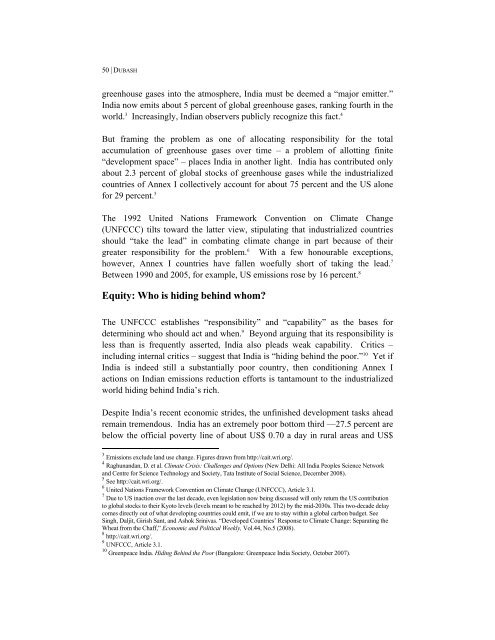Indian Climate Policy - Global Commons Institute
Indian Climate Policy - Global Commons Institute
Indian Climate Policy - Global Commons Institute
Create successful ePaper yourself
Turn your PDF publications into a flip-book with our unique Google optimized e-Paper software.
50 | DUBASH<br />
greenhouse gases into the atmosphere, India must be deemed a “major emitter.”<br />
India now emits about 5 percent of global greenhouse gases, ranking fourth in the<br />
world. 3 Increasingly, <strong>Indian</strong> observers publicly recognize this fact. 4<br />
But framing the problem as one of allocating responsibility for the total<br />
accumulation of greenhouse gases over time – a problem of allotting finite<br />
“development space” – places India in another light. India has contributed only<br />
about 2.3 percent of global stocks of greenhouse gases while the industrialized<br />
countries of Annex I collectively account for about 75 percent and the US alone<br />
for 29 percent. 5<br />
The 1992 United Nations Framework Convention on <strong>Climate</strong> Change<br />
(UNFCCC) tilts toward the latter view, stipulating that industrialized countries<br />
should “take the lead” in combating climate change in part because of their<br />
greater responsibility for the problem. 6 With a few honourable exceptions,<br />
however, Annex I countries have fallen woefully short of taking the lead. 7<br />
Between 1990 and 2005, for example, US emissions rose by 16 percent. 8<br />
Equity: Who is hiding behind whom?<br />
The UNFCCC establishes “responsibility” and “capability” as the bases for<br />
determining who should act and when. 9 Beyond arguing that its responsibility is<br />
less than is frequently asserted, India also pleads weak capability. Critics –<br />
including internal critics – suggest that India is “hiding behind the poor.” 10 Yet if<br />
India is indeed still a substantially poor country, then conditioning Annex I<br />
actions on <strong>Indian</strong> emissions reduction efforts is tantamount to the industrialized<br />
world hiding behind India’s rich.<br />
Despite India’s recent economic strides, the unfinished development tasks ahead<br />
remain tremendous. India has an extremely poor bottom third —27.5 percent are<br />
below the official poverty line of about US$ 0.70 a day in rural areas and US$<br />
3 Emissions exclude land use change. Figures drawn from http://cait.wri.org/.<br />
4 Raghunandan, D. et al. <strong>Climate</strong> Crisis: Challenges and Options (New Delhi: All India Peoples Science Network<br />
and Centre for Science Technology and Society, Tata <strong>Institute</strong> of Social Science, December 2008).<br />
5 See http://cait.wri.org/.<br />
6 United Nations Framework Convention on <strong>Climate</strong> Change (UNFCCC), Article 3.1.<br />
7 Due to US inaction over the last decade, even legislation now being discussed will only return the US contribution<br />
to global stocks to their Kyoto levels (levels meant to be reached by 2012) by the mid-2030s. This two-decade delay<br />
comes directly out of what developing countries could emit, if we are to stay within a global carbon budget. See<br />
Singh, Daljit, Girish Sant, and Ashok Srinivas. “Developed Countries’ Response to <strong>Climate</strong> Change: Separating the<br />
Wheat from the Chaff,” Economic and Political Weekly, Vol.44, No.5 (2008).<br />
8 http://cait.wri.org/.<br />
9 UNFCCC, Article 3.1.<br />
10 Greenpeace India. Hiding Behind the Poor (Bangalore: Greenpeace India Society, October 2007).
















